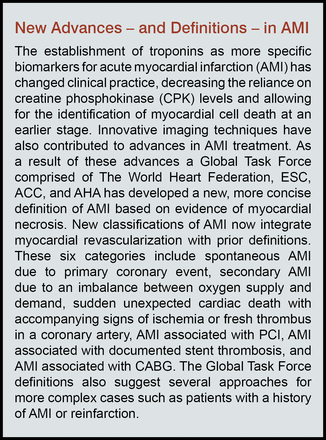Summary
The 2008 European Society of Cardiology Congress (ESC) in Munich featured the new ESC clinical practice guidelines for the diagnosis and treatment of major cardiac events and conditions such as ST-segment elevation myocardial infarction, heart failure, and pulmonary embolism.
- myocardial infarction
- heart failure
- pulmonary guidelines guidelines
The 2008 European Society of Cardiology Congress (ESC) in Munich featured the new ESC clinical practice guidelines for the diagnosis and treatment of major cardiac events and conditions such as ST-segment elevation myocardial infarction, heart failure, and pulmonary embolism. These consensus-driven, practice-changing guidelines promote informed clinical decision making by creating a comprehensive standard of care for cardiac patients. The scientific recommendations are determined by experts in the field of cardiology who are members of associations, working groups, and councils of the ESC under the responsibility of the Committee for Practice Guidelines and the ESC Board. All diagnostic treatment options are classified according to the strength of the recommendation and the level of evidence currently available. The ESC Committee took this opportunity to also create a shortlist of issues meriting further clinical research due to inconclusive evidence.
Heart Failure
This year, the heart failure guidelines combined recommendations on both acute and chronic heart failure (HF). Diagnostic testing plays a large role in the treatment of HF. The ESC guidelines provide a thorough evaluation of the numerous diagnostic tests and imaging techniques outlining common diagnostic abnormalities and their implications in HF. They also emphasize the importance of self-management for patients with HF including symptom recognition, immunizations, risk factor and lifestyle modifications, and adherence to treatment. In addition, the guidelines focus on the impact of patient education, knowledge of medical treatment, and realistic expectations concerning response to therapy on adherence to treatment and patient morbidity and mortality.
ST-segment Elevation Myocardial Infarction
The ST-segment elevation myocardial infarction (STEMI) guidelines focus on the point at which STEMI is identified and provides treatment options based on the medical resources upon presentation. Implementation of primary PCI is dependent upon the patient's presenting at a PCI hospital within 2 hours of STEMI. Therefore, a patient presenting at a non-PCI hospital or by ambulance after the 2 hour window does not have the option of PCI and the guidelines suggest thrombolysis with follow-up angiography. The new STEMI guidelines call for hospitals with different technological capabilities to collaborate in order to ensure consistent optimal care for STEMI patients. The guidelines also examine primary PCI versus fibrinolytic therapy and the role of antithrombotic co-therapies for STEMI. The important role of secondary prevention and rehabilitation is also highlighted in this report.
ECG Monitor.
Acute Pulmonary Embolism
Acute pulmonary embolism (PE) is another topic covered in the ESC guidelines. Diagnostic procedures are pivotal in the management of PE, as it can be a diagnostic enigma, and early diagnosis offers more favorable treatment outcomes. For this reason, a tiered approach to diagnostic testing is featured in the new report, grading diagnostic procedures, as well as treatment options, based on supporting scientific evidence obtained from accuracy and outcome studies. These algorithms include testing combinations to assist clinicians in properly diagnosing or ruling out PE.
A critical addition has been made to these guidelines with the inclusion of a prognostic assessment for PE. Clinical, imaging, and laboratory findings are evaluated and risk stratified (high-, intermediate-, and low-risk) in order to calculate the likelihood of death or risk of complication in the early period of hospitalization in a PE patient. Treatment options are offered according to a patient's prognostic evaluation. Aggressive treatment strategies such as thrombolytic drugs or surgical intervention are recommended for high-risk cases while more conservative methods of treatment, such as anticoagulants, are suggested for low-risk cases. Secondary prevention approaches as well as complicated presentations such as pregnancy, malignancy, right heart thrombi and heparin-induced thrombocytopenia are also included in this revised report.
The tiered clinical approach in these guidelines, new classifications, and the comprehensive grading process will further assist healthcare professionals in providing optimal care to cardiac patients. Besides the executive summary published in the European Heart Journal, practical summaries are available in the format of pocket guidelines, which are extremely popular since several millions have already been distributed worlwide during the recent years. The ESC Guidelines are comprehensive practice-changing tools that will be utilized by clinicians worldwide. For more information about the ESC and to access the full ESC guidelines visit the ESC web site at www.escardio.org/guidelines.
New Advances – and Definitions – in AMI

The establishment of troponins as more specific biomarkers for acute myocardial infarction (AMI) has changed clinical practice, decreasing the reliance on creatine phosphokinase (CPK) levels and allowing for the identification of myocardial cell death at an earlier stage. Innovative imaging techniques have also contributed to advances in AMI treatment. As a result of these advances a Global Task Force comprised of The World Heart Federation, ESC, ACC, and AHA has developed a new, more concise definition of AMI based on evidence of myocardial necrosis. New classifications of AMI now integrate myocardial revascularization with prior definitions. These six categories include spontaneous AMI due to primary coronary event, secondary AMI due to an imbalance between oxygen supply and demand, sudden unexpected cardiac death with accompanying signs of ischemia or fresh thrombus in a coronary artery, AMI associated with PCI, AMI associated with documented stent thrombosis, and AMI associated with CABG. The Global Task Force definitions also suggest several approaches for more complex cases such as patients with a history of AMI or reinfarction.
- © 2008 MD Conference Express












